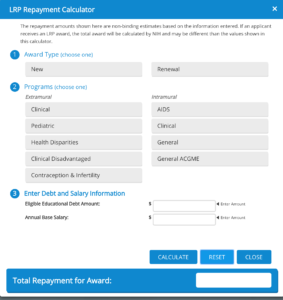NIH Wants to Pay Your Student Loans. Here’s How to Make It Easier for Them to Do It.
NIH up to $100,000 a year for you to pay down your student debt and you really should let them give it to you. If you’re a health professional in biomedical or biobehavioral research and in need of paying down your student debt, NIH’s Loan Repayment Program offers a fantastic way to pay down the debt while focusing on developing your research career. I had the pleasure of serving on a Loan Repayment Program study section this summer and can offer you the inside scoop on how to maximize your chances of success.

Snazzy Loan Repayment Calculator on NIH’s Website.
- NIH wants you to succeed. The paylines for these grants are the most generous I’ve seen. More funded than unfunded applications? That’s crazy good!
- Don’t miss the window. LRP is looking for folks who have obtained an advanced degree (PhD, MD, DVM etc) and are just venturing out into fellowships. If you are at all uncertain, call the program officers or talk to the plentiful ambassadors that are around most institutions. This cycle will accept applications from September 1 through November 15.
- You will need to have a debt to income ratio of 20%. Use this handy calculator for specifics.
- You need to be a US citizen or permanent resident.
A word about your applications. This program is not just about paying down your debt. If you start your essay “I really would like to have debt forgiveness so it will be one less thing for me and my new family to worry about while I’m doing my super important residency at super important school” it will go poorly.
While it’s okay (and even normal) to think you’d like to not have to worry about student loans, the purpose of the program is to place trainees in positions where they are most needed. With programs in clinical research for AIDS, infertility, underrepresented minorities, and more, the NIH has targeted areas where it wants more young talent. Simply being talented isn’t sufficient. You have to show you have a program of research you will engage in that is well mentored and will help you develop a skill set as a researcher.
Things that tell me you’re sort of a rockstar:
- You’ve done your IRB training. It’s a small add to your Personal Statement, but getting the busy work out of the way says you know what’s involved in interacting with patients in a research setting. If you want to make me put ⭐️gold stickers⭐️ on your application, have an IRB approved by the time you have your application submitted.
- You’ve pulled together and met with an awesome mentoring committee. Having a PI you can work with is critical, but now is the time to call in favors. Get that amazing statistics person from the department to agree to come to a meeting where you talk specifically about your project. Then pull in two more folks with externally funded research programs. Maybe a nice basic science person who can help you level up your blood analysis and someone doing similar measures in another condition? Yeah, I like the cut of your jib if you’ve done this.
- You understand you need to use your time to learn from your mentor and independence will come. Proposing an aggressive program that your mentor isn’t funded to study may be genius, but this program looks for folks who are going to learn from the expertise, infrastructure and resources that are around.
Things that tell me you may be heading for rocky shores:
- Your biosketch is formatted for 2010. The biosketch format was updated in 2015 and if you’re still using an old one, it just means that whoever is helping you hasn’t put in a grant in a long time. Or you are just winging the LRP program without a mentor. Neither is good.
- Your mentor just met you. Letters of support are critically important in this application. You should already be attending group meetings, going to Grand Rounds and talking to PIs who have independent grant funding. Their letters about who you are and how your career will be fostered by their experience and resources is critical to your success. And by critical, I mean irreplaceable. And by irreplaceable, I mean don’t even bother to put in a LRP application if you don’t have a real relationship with a research mentor.
- You don’t know your Resources and Environment. If I know your school has an amazing DNA database or proteomics group and you haven’t mentioned it even though it’s a natural extension of a program you are considering, I’ll think your career isn’t for the long haul.
- The Review Article You Wrote: Remember that scene from Star Wars where Admiral Ackbar screams, “It’s a trap?” Review articles are more often than not mentors’ ways of punishing you for not reading the literature. If you aren’t totally up to speed on the clinical relevance of your work and talking about new literature, I’ll probably ask you to write a review. Because that will make you read.
- Your Well Intentioned but Unfunded Mentor: Funding is a not good now. Respect the realities of PIs who have had to revamp their programs, write frantically and move heaven and earth to get money. If your PI is struggling to get funding, they won’t have much bandwidth to help you. Respect that and put them on your mentoring committee for their thoughts, but using them as your primary mentor is going to be tough on them and you.
There are going to be a lot of folks who dislike that last comment, so release the hounds in the Comments, Smithers.







0 Comments